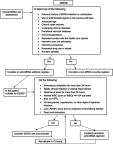Tedizolid phosphate for the treatment of acute bacterial skin and skin-structure infections: an evidence-based review of its place in therapy
- PMID: 31308835
- PMCID: PMC6615724
- DOI: 10.2147/CE.S187499
Tedizolid phosphate for the treatment of acute bacterial skin and skin-structure infections: an evidence-based review of its place in therapy
Abstract
Introduction: Tedizolid phosphate is an oxazolidinone approved for the treatment of acute bacterial skin and skin-structure infections (ABSSSIs) and active against methicillin-resistant Staphylococcus aureus.
Aims: The objective of this article was to review the evidence for the efficacy and safety of tedizolid phosphate for the treatment of ABSSSI.
Evidence review: Approval of tedizolid phosphate for the treatment of ABSSSI was based on the results of two phase III randomized controlled trials, ESTABLISH-1 (NCT01170221) and ESTABLISH-2 (NCT01421511), comparing 6-day once-daily tedizolid vs 10-day twice-daily linezolid. In ESTABLISH-1, noninferiority was met with early clinical response rates of 79.5% and 79.4% in tedizolid and linezolid groups, respectively (difference 0.1%, 95% CI -6.1% to 6.2%, with a 10% noninferiority margin). In ESTABLISH-2, noninferiority was met with 85% and 83% rates of early clinical response in tedizolid and linezolid groups, respectively (difference 2.6%, 95% CI -3.0% to 8.2%). Pooled data from ESTABLISH-1 and ESTABLISH-2 indicated a lower frequency of thrombocytopenia in tedizolid-treated than in linezolid-treated patients.
Conclusion: Tedizolid offers the option of an intravenous to oral switch, allows once-daily administration, and presents lower risk of myelotoxicity when a 6-day course is used for the treatment of ABSSSI. Greater economic cost associated with this antibiotic could be offset by its shorter treatment duration and possibility of oral administration in routine clinical practice, although either sponsored or nonsponsored postmarketing observational experience remains essential for ultimately confirming the effectiveness and tolerability of tedizolid outside clinical trials.
Keywords: ABSSSI; MRSA; Staphylococcus; efficacy; oxazolidinone; safety.
Conflict of interest statement
MB reports grants and personal fees from Pfizer, MSD, and Cidara and personal fees from Astellas and Gilead outside the submitted work. DRG reports personal fees from Stepstone Pharma GmbH and an unconditional grant from MSD Italia outside the submitted work. The other authors report no conflicts of interest in this work.
Figures

Similar articles
-
Tedizolid phosphate vs linezolid for treatment of acute bacterial skin and skin structure infections: the ESTABLISH-1 randomized trial.JAMA. 2013 Feb 13;309(6):559-69. doi: 10.1001/jama.2013.241. JAMA. 2013. PMID: 23403680 Clinical Trial.
-
Tedizolid and Linezolid for Treatment of Acute Bacterial Skin and Skin Structure Infections of the Lower Extremity versus Non-Lower-Extremity InfectionsPooled Analysis of Two Phase 3 Trials.J Am Podiatr Med Assoc. 2017 Jul;107(4):264-271. doi: 10.7547/15-218. Epub 2016 Aug 17. J Am Podiatr Med Assoc. 2017. PMID: 27533787
-
Platelet profile in patients with acute bacterial skin and skin structure infections receiving tedizolid or linezolid: findings from the Phase 3 ESTABLISH clinical trials.Antimicrob Agents Chemother. 2014 Dec;58(12):7198-204. doi: 10.1128/AAC.03509-14. Epub 2014 Sep 22. Antimicrob Agents Chemother. 2014. PMID: 25246392 Free PMC article. Clinical Trial.
-
Tedizolid: a novel oxazolidinone with potent activity against multidrug-resistant gram-positive pathogens.Drugs. 2015 Feb;75(3):253-70. doi: 10.1007/s40265-015-0352-7. Drugs. 2015. PMID: 25673021 Review.
-
Profile of tedizolid phosphate and its potential in the treatment of acute bacterial skin and skin structure infections.Infect Drug Resist. 2015 Apr 22;8:75-82. doi: 10.2147/IDR.S56691. eCollection 2015. Infect Drug Resist. 2015. PMID: 25960671 Free PMC article. Review.
Cited by
-
Tedizolid-Cyclodextrin System as Delayed-Release Drug Delivery with Antibacterial Activity.Int J Mol Sci. 2020 Dec 24;22(1):115. doi: 10.3390/ijms22010115. Int J Mol Sci. 2020. PMID: 33374358 Free PMC article.
-
Tedizolid-Rifampicin Combination Prevents Rifampicin-Resistance on in vitro Model of Staphylococcus aureus Mature Biofilm.Front Microbiol. 2020 Aug 28;11:2085. doi: 10.3389/fmicb.2020.02085. eCollection 2020. Front Microbiol. 2020. PMID: 32983061 Free PMC article.
-
Novel antimicrobial strategies for diabetic foot infections: addressing challenges and resistance.Acta Diabetol. 2025 Mar;62(3):303-321. doi: 10.1007/s00592-024-02438-3. Epub 2025 Jan 6. Acta Diabetol. 2025. PMID: 39760785 Review.
-
Side-by-Side Profiling of Oxazolidinones to Estimate the Therapeutic Window against Mycobacterial Infections.Antimicrob Agents Chemother. 2023 Apr 18;67(4):e0165522. doi: 10.1128/aac.01655-22. Epub 2023 Mar 15. Antimicrob Agents Chemother. 2023. PMID: 36920191 Free PMC article.
-
Safety and tolerability of tedizolid as oral treatment for bone and joint infections.Microbiol Spectr. 2023 Sep 26;11(5):e0128223. doi: 10.1128/spectrum.01282-23. Online ahead of print. Microbiol Spectr. 2023. PMID: 37750695 Free PMC article.
References
-
- Garau J, Ostermann H, Medina J, et al. Current management of patients hospitalized with complicated skin and soft tissue infections across Europe (2010–2011): assessment of clinical practice patterns and real-life effectiveness of antibiotics from the REACH study. Clin Microbiol Infect. 2013;19(9):E377–E385. doi:10.1111/1469-0691.12235 - DOI - PubMed
-
- Pallin DJ, Egan DJ, Pelletier AJ, Espinola JA, Hooper DC, Camargo CA Jr. Increased US emergency department visits for skin and soft tissue infections, and changes in antibiotic choices, during the emergence of community-associated methicillin-resistant Staphylococcus aureus. Ann Emerg Med. 2008;51(3):291–298. doi:10.1016/j.annemergmed.2007.12.004 - DOI - PubMed
-
- Chua K, Laurent F, Coombs G, Grayson ML, Howden BP. Antimicrobial resistance: not community-associated methicillin-resistant Staphylococcus aureus (CA-MRSA)! A clinician’s guide to community MRSA - its evolving antimicrobial resistance and implications for therapy. Clin Infect Dis. 2011;52(1):99–114. doi:10.1093/cid/ciq067 - DOI - PubMed
LinkOut - more resources
Full Text Sources
Miscellaneous

